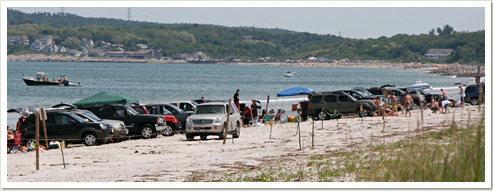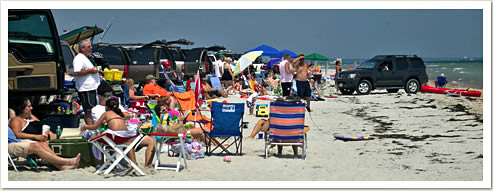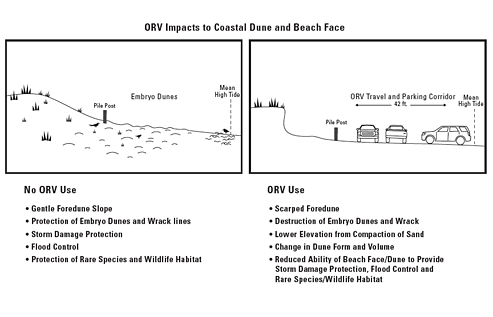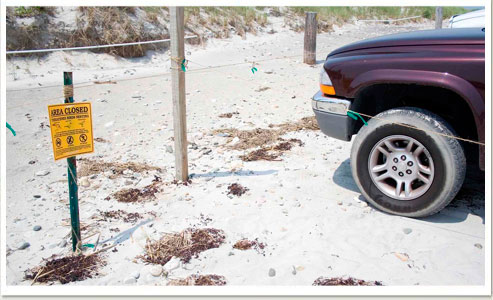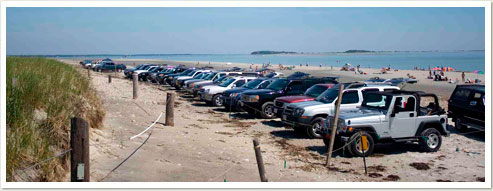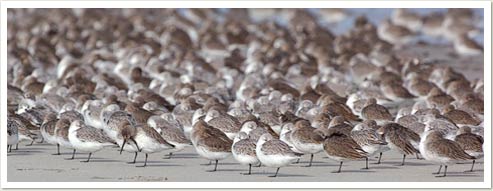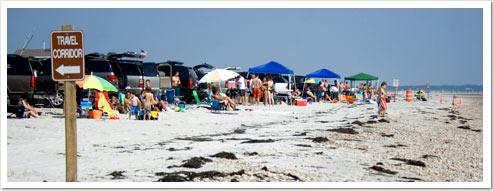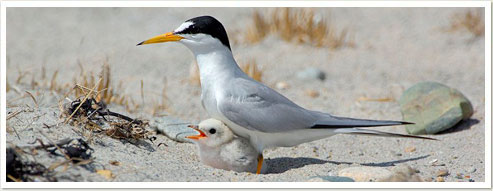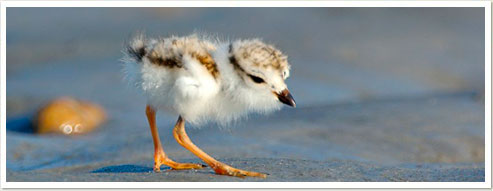|
||||||
 |
|
|
||||||||||||||||||||||||||||||||||||||||||||||||||||||||
| Beach Management Plan Plymouth Long Beach In February 2008, the Town of Plymouth proposed a Beach Management Plan to the local Conservation Commission. The Town’s permit to allow Off-Road Vehicles (ORVs) on Plymouth Long Beach had lapsed in 2006. During two public hearings, several regional, state and national conservation organizations joined Plymouth residents and beach property owners in questioning the proposed Plan’s compliance with the Massachusetts Wetlands Protection Act (WPA). Despite the issues and objections raised at the public hearings, the Conservation Commission approved the Plan in March 2008 as proposed by the Town of Plymouth. |
|||||||||||||||||||||||||||||||||||||||||||||||||||||||||
|
In April 2008, the Goldenrod Foundation, joined by Defenders of Wildlife and two citizen groups in Plymouth, filed an administrative appeal with the Massachusetts Department of Environmental Protection (DEP). The appeal requested a Superceding Order of Conditions to correct the failure of the Beach Management Plan to comply with the WPA. In addition, the Goldenrod Foundation, Defenders of Wildlife and citizen groups submitted comments to the Massachusetts Division of Fish & Wildlife (MDFW) documenting the Plan’s failure to comply with the Massachusetts Endangered Species Act (MESA). |
|||||||||||||||||||||||||||||||||||||||||||||||||||||||||
|
|||||||||||||||||||||||||||||||||||||||||||||||||||||||||
Wetlands Protection Act The Goldenrod Foundation’s appeal to DEP for a Superceding Order of Conditions is based on the legal inadequacy of the Beach Management Plan to comply with the WPA in three major respects.1. Storm Damage: Failure to protect wetlands resources on Plymouth Beach that help prevent storm damage to Plymouth Harbor and property behind the barrier beach. 2. Rare Species Habitat: Failure to protect the habitat on Plymouth Beach of rare species of birds protected by the Massachusetts Endangered Species Act (MESA) and the U.S. Endangered Species Act (ESA) and 3. Migratory Shorebird Habitats: Failure to protect signficant wildlife habitat of migratory shorebirds. 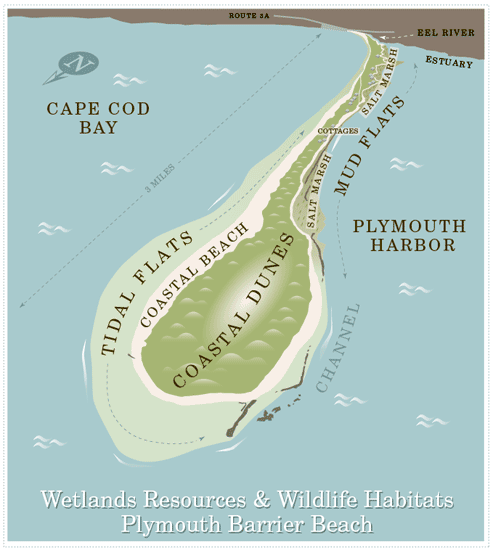 1. Storm Damage Prevention and Flood Control The Town of Plymouth Beach Management Plan fails to adequately protect wetlands resources that help prevent storm damage. Plymouth Long Beach forms a natural barrier between Cape Cod Bay and Plymouth Harbor. The ability of the barrier beach and coastal dune system to respond to and recover from storms is crucial to protecting the harbor ecosystem and the mainland areas behind the barrier. To ensure this protection, the WPA sets standards to safeguard the dune system and the natural processes that form dunes.
|
|||||||||||||||||||||||||||||||||||||||||||||||||||||||||
|
In order to provide ORV recreational use, the Town of Plymouth lays out a Vehicle Travel and Parking Corridor along the edge of the Mean High Tide (MHT) line. The Town establishes the ORV Travel and Parking Corridor at the same width from the MHT-- 42ft -- wherever parking is permitted on the beachfront. This practice leads to violations of the WPA. In sections where the beach is narrow, ORVs park and drive on top of embryo dunes and vegetation where they do the greatest damage to the dune ecosystem. ORVs park or drive too close to the primary dune, undermining the dune system’s role in preventing storm damage.
ORVs in the Travel Corridor destroy wrack as it washes up on the beach. Beach wrack is a critical source of nutrients for vegetation and seeds for embryo dune pioneer plants. When wrack is crushed and buried in ORV tire ruts, it does not provide the sand trapping fuction to form embryo dunes. The wider the ORV Corridor, the greater is the damage to wrack. The WPA protects these resources because of their role in dune formation. |
|||||||||||||||||||||||||||||||||||||||||||||||||||||||||
|
|||||||||||||||||||||||||||||||||||||||||||||||||||||||||
|
|||||||||||||||||||||||||||||||||||||||||||||||||||||||||
The Plymouth Beach Management Plan violates the standards and regulations of the WPA for protecting the habitat of rare species. The full length of the beachfront is breeding, nesting, feeding and resting habitat for rare species.
|
|||||||||||||||||||||||||||||||||||||||||||||||||||||||||
| Currently, the town does things "backwards" from a legal perspective. The Town does not first delineate adequate space to protect the habitat of rare species and then determine if there is sufficient width for an ORV Travel Corridor and Parking area. Rather, the Town first establishes an ORV Corridor for both Travel and Parking along the entire beachfront, wherever parking is permitted. Whatever area remains between the 42ft ORV Corridor and the primary dune is then delineated with symbolic fencing. In sections where the beach is narrow, this practice allows ORVs to park and drive in the habitat of rare species. ORVs displace Piping Plovers and Least Terns from using suitable nesting areas. The width of the ORV Travel Corridor allows ORVs to destroy and pulverize wrack. Beach wrack contains invertebrates that are an essential food source for piping plovers and other shorebirds, and provides protective cover from avian predators. |
|||||||||||||||||||||||||||||||||||||||||||||||||||||||||
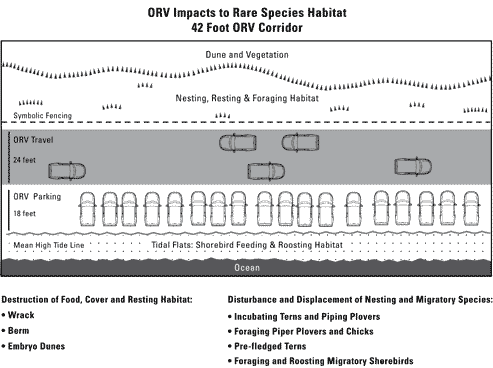 |
|||||||||||||||||||||||||||||||||||||||||||||||||||||||||
It is against the law in Massachusetts to “harass, harm, pursue, hunt, shoot, hound, kill, trap, capture, collect, process, disrupt the nesting, breeding, feeding or migratory activity or attempt to engage in any such conduct or to assist such conduct” of any species listed as Endangered, Threatened or of Special Concern. The Natural Heritage and Endangered Species Program (NHESP) of the Mass Division of Fisheries and Wildlife produced Guidelines for beach managers and private property owners to follow in order to comply with the law.
The Roseate Tern and Piping Plover are Endangered and Threatened species under the U.S. Endangered Species Act (ESA). In addition to the small numbers of Roseate Terns that nest on Plymouth Beach at the tip of the barrier beach, globally significant numbers of Roseate Terns gather on large areas of Plymouth Beach mid-July through mid-September to prepare for migration. The entire beachfront is nesting, feeding and resting habitat for Piping Plovers. Under the ESA, the following activities are a federal crime: “Harassing, harming, pursuing, hunting, shooting, wounding, killing, trapping, capturing or collecting wildlife species.” It is also against the law to “attempt such acts, solicit another to commit such acts, or cause such acts to be committed.” Regulations of the ESA define harass as follows: “An intentional or negligent act or omission which creates the likelihood of injury to wildlife by annoying it to such an extent as to significantly disrupt normal behavioral patterns which include, but are not limited to breeding, feeding or sheltering.” The United State Fish & Wildlife Service has produced federal Guidelines for managing recreational activities in the breeding habitat of Piping Plovers to avoid violations of the law. Just as the Town of Plymouth does not follow important provisions of the state Guidelines for piping plovers and terns, the Town ignores the federal Guidelines for buffer distances between ORVs and nests of piping plovers. Like the Guidelines for MESA, USFW Guidelines for ESA also specify that: “Pets should be prohibited on beaches where piping plovers are present or have traditionally nested, if based on observations and experience, pet owners fail to keep pets leashed and under control.” Again, the Town has not prohibited dogs on Plymouth Beach despite a well-documented and persistent pattern of unleashed dogs harassing birds, including the endangered Piping Plover and Roseate Tern. In 1998, the U.S. Attorney’s Office in Boston filed suit against the Town of Plymouth on behalf of the U.S. Fish & Wildlife Service for violating the U.S. Endangered Species Act. A federal court judge ordered the Town to implement specific measures of the US Fish & Wildlife Service management Guidelines for piping plovers, including establishing protective zones around the nests of these endangered shorebirds. Document Archive > |
|||||||||||||||||||||||||||||||||||||||||||||||||||||||||
